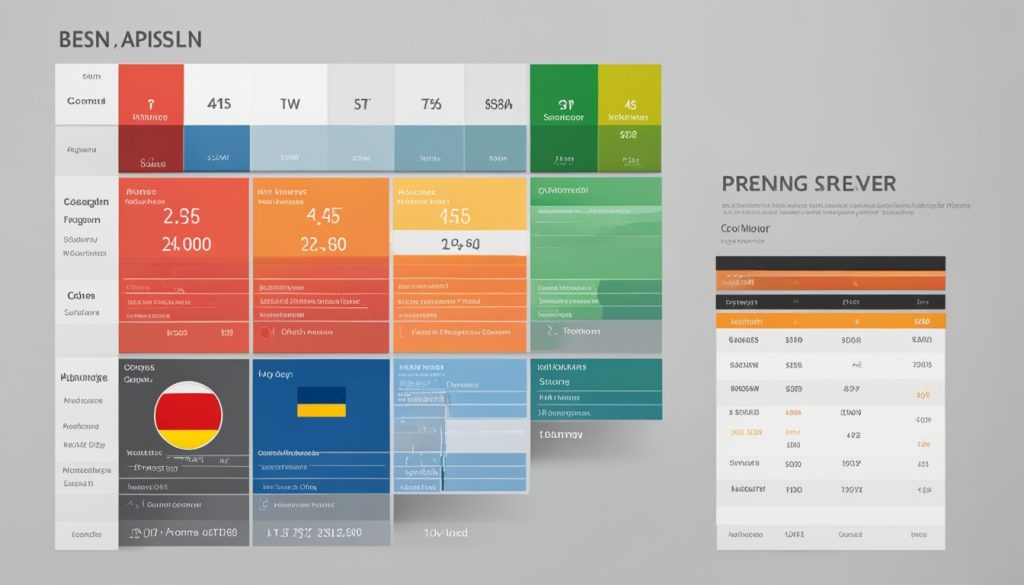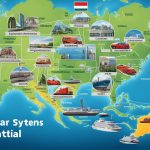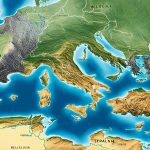When we compare the economies of Belgium, Spain, and the Netherlands, we see clear differences. Each country has something unique to offer. The Netherlands is known for its commitment to environmental sustainability. Spain is celebrated for its lively culture. Belgium is respected for its strong social welfare system.
Understanding these differences in living standards and costs is crucial. It helps us grasp how each nation ranks globally. This detailed analysis provides everything you need to know. It aids in making well-informed choices regarding the Belgium vs Spain vs Netherlands debate.
Overview of Belgium, Spain, and Netherlands
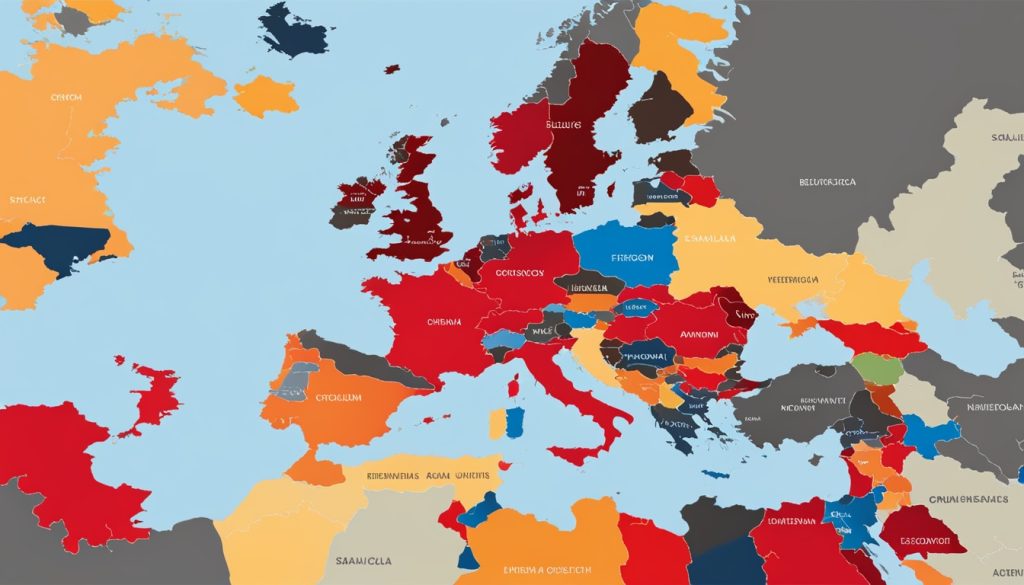
Exploring Western Europe, we see what makes Belgium, Spain, and the Netherlands special. These countries add to Europe’s rich culture. They also provide unique living experiences. This comes from their location, languages, and way they are run.
Belgium plays a big part with its three languages: French, Dutch, and German. It has a federal system and a king or queen, with Brussels at its core. Brussels is also key in European politics.
- Belgium: Federal parliamentary constitutional monarchy; multilingual – French, Dutch, and German; Capital – Brussels.
- Spain: Parliamentary constitutional monarchy; Spanish as its official language; Capital – Madrid.
- Netherlands: Parliamentary constitutional monarchy; Dutch language; Capital – Amsterdam.
Spain brings Southern Europe’s warmth. Its culture and weather are inviting. Madrid, its capital, pulsates with life. Spain speaks Spanish and is run by a monarchy.
The Netherlands has a long history. It once dominated the seas and trade. Its powerful economy today reflects this past. Amsterdam, its capital, is a cultural and trading hub.
- Belgium’s geographical diversity includes dense urban regions and picturesque countryside.
- Spain’s regional richness encompasses everything from coastal havens to mountainous terrain.
- The Netherlands boasts an extensive network of canals, reflecting its history as a maritime power.
Looking at these countries together, we appreciate their roles in Europe’s story. Each has its own style of governance, culture, and landscape. Belgium, Spain, and the Netherlands are key to Europe’s diversity.
Economic Indicators: A Comparative Analysis
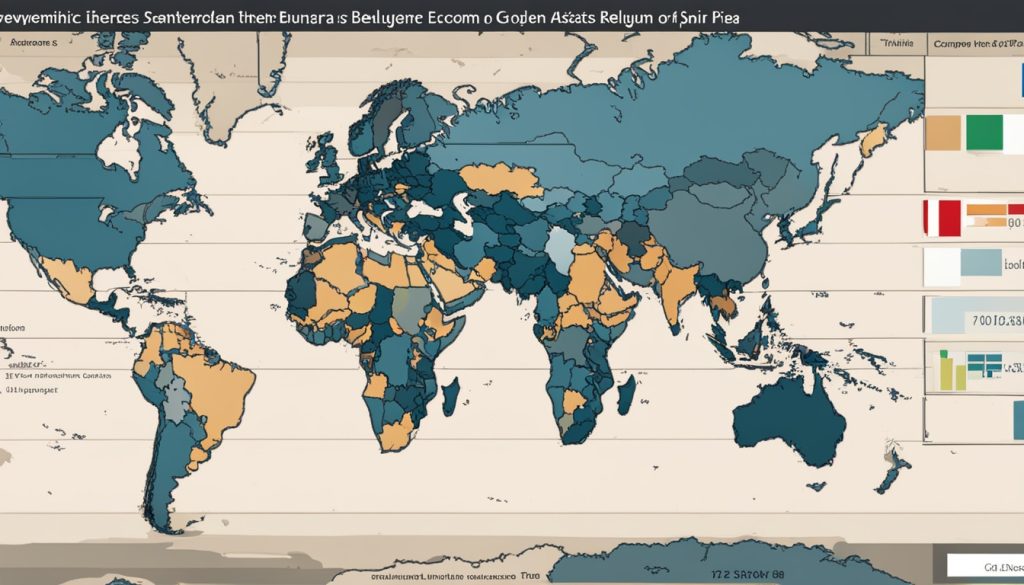
Looking at the economy of Belgium, Spain, and the Netherlands, we compare crucial indicators. These indicators show the economic size, how sustainable it is, and the life quality of the people. We assess the GDP, income levels, and market stability of these countries. Our analysis sheds light on their different economic strengths and challenges.
This includes a look at GDP, income differences, and how employment and prices affect living standards and income.
Gross Domestic Product (GDP)
Comparing GDP gives us insight into the economic strengths of Belgium, Spain, and the Netherlands. Belgium’s GDP is USD 583,436 million, showing a strong economy. On the other hand, Spain’s GDP is much bigger, at USD 1,417,800 million. The Netherlands also shows strong economic performance.
Average Income and Wages
Looking at salaries and wages helps us understand people’s living standards. Belgium’s people earn a lot, with an average income of USD 53,890. Spain’s earnings are lower, with an average income of USD 32,090, showing big differences in what people earn in these countries.
Unemployment Rates
Unemployment figures give us a glimpse of job availability. Belgium’s unemployment rate is low at 5.6%, showing a strong job market. Spain, however, has a higher unemployment rate of 13.0%. This difference points to varying job market challenges.
Inflation Rates
Inflation rates tell us about price stability and living costs. Belgium’s inflation rate is 9.60%, which is quite high. Spain has a lower inflation rate of 8.39%. These rates indicate that both countries are facing costs that could change how people spend.
Cost of Living in Belgium, Spain, and Netherlands
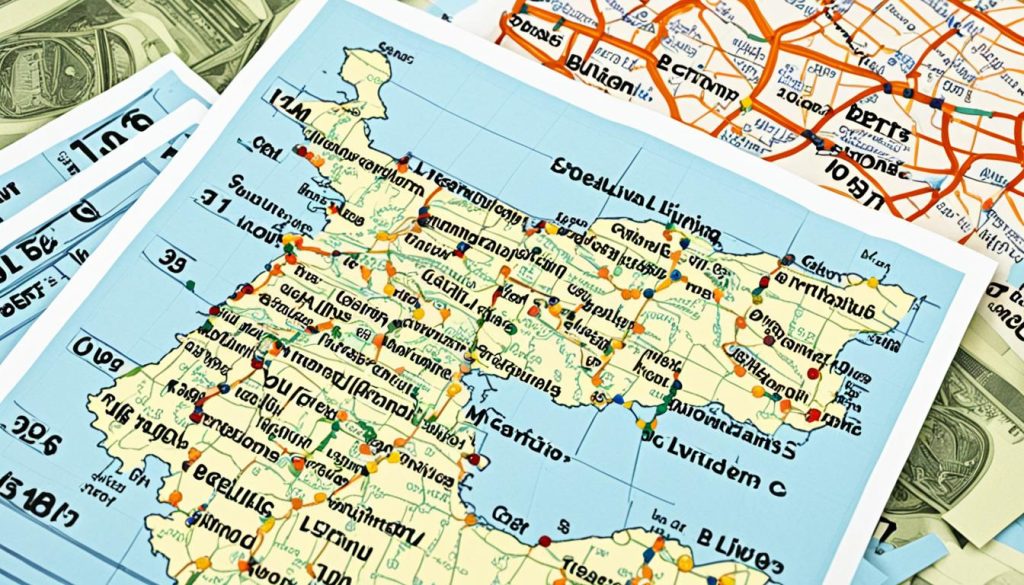
It’s vital to know the cost of living in different countries, especially for those thinking about moving. Europe’s diverse economies make the price index an important measure. This index shows us the cost comparison and living expenses one might face. In Belgium, the cost of living index is 86.77% compared to the USA’s 100%. This tells us that Belgium’s consumer prices are quite high relative to the US.
Spain, however, is more affordable with a price index of 72.96%. This lower index means living in Spain could be cheaper than in Belgium. But it’s also important to think about how much people earn in these countries.
The Netherlands has higher pay than Spain’s Costa del Sol. This difference in income highlights the varying living expenses and economic situations of these places. So, if you’re thinking of moving or investing, it’s key to compare both consumer prices and wages.
- Belgium’s Cost of Living Index: 86.77% relative to the USA’s 100%
- Spain’s Affordability: A more budget-friendly option with a cost index at 72.96%
- Dutch Salaries vs. Costa del Sol: Higher net salaries in the Netherlands show a significant difference in regional affordability
In summary, the relationship between earnings, cost of living, and consumer prices in Belgium, Spain, and the Netherlands offers much to consider. This directly affects the affordability and life quality in these countries.
Quality of Healthcare Services
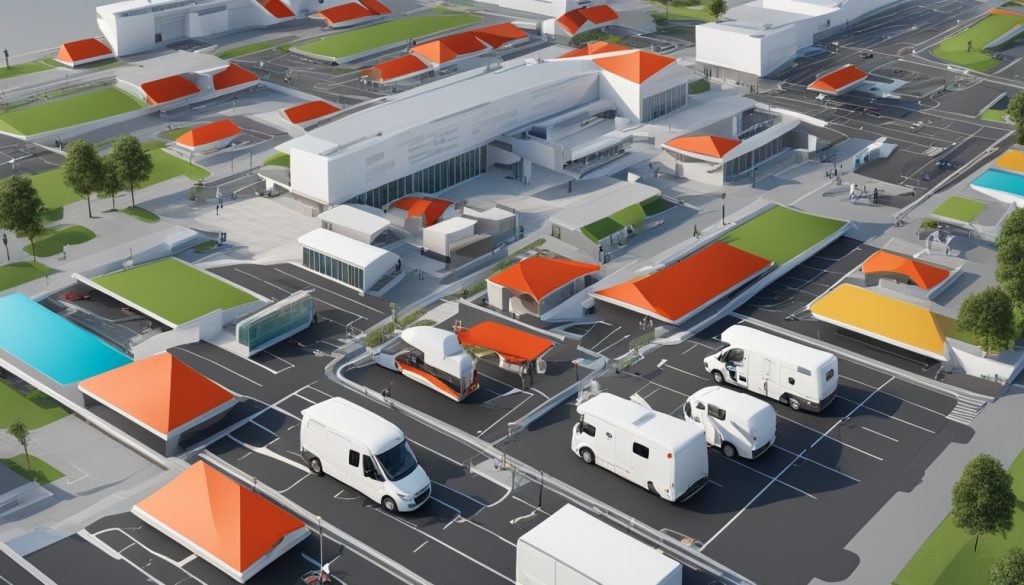
Studying healthcare in European countries shows us how good their healthcare systems are. We look at hospital beds and how many doctors there are per person. These tell us about patient care quality. Belgium and Spain have worked hard to make healthcare better. But, they are different in health scores and sickness rates. This shows how their health and medical care stand apart.
Hospital Beds and Physicians per Inhabitant
Belgium is ahead with its strong support for patients. It has more hospital beds for each person, 5.58 beds, while Spain has 2.97. Also, Belgium has more doctors, with 6.26 per 1,000 people. Spain has 4.58. This highlights Belgium’s strong healthcare system.
Disease Prevalence and Healthcare Quality
Looking at chronic illnesses tells us about healthcare quality. Belgium has fewer people with diabetes, only 3.6%. Spain’s rate is much higher at 10.3%. This difference gives insight into the success of their healthcare approaches. Belgium also scores higher on health indexes, 93 compared to Spain’s 86. This shows Belgium’s health management is better.
Employment Opportunities and Worker Benefits
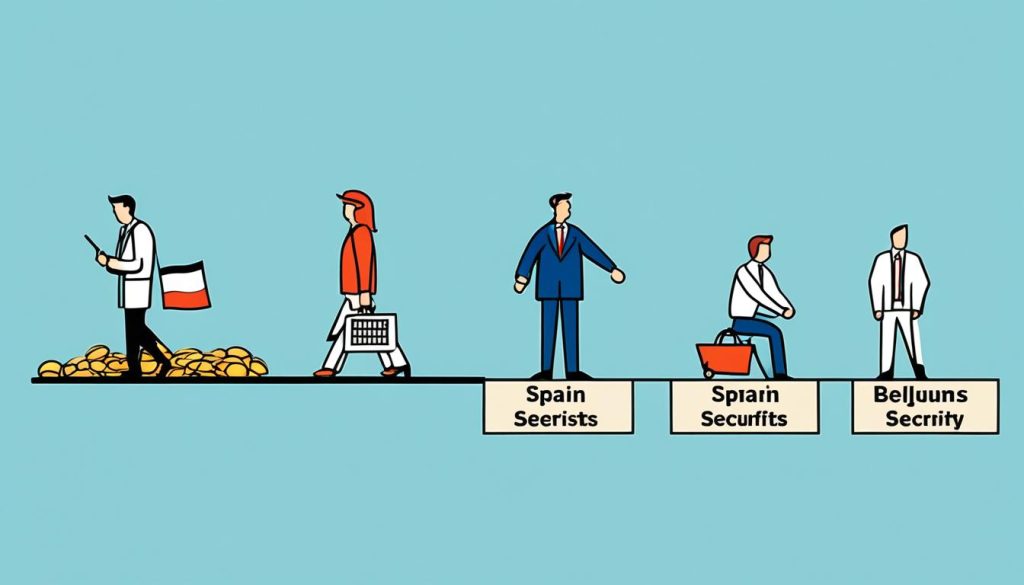
The job market varies a lot between countries like Belgium and Spain. Belgium has higher employment rates and strong social security systems. This shows Belgium might have better opportunities for job hunters. The way labour rights are handled also differs, which can affect how happy and productive workers are.
- Job Market Vitality: Compared to Spain, Belgium’s unemployment rates are usually lower. This suggests a livelier job scene with more chances for employment in different areas.
- Labor Rights and Protections: Both countries boast solid labor rights. However, the way these rights are applied and enforced differs. This influences the working conditions in each country.
Social security is key in both nations, giving different levels of protection to workers. These systems are crucial for the well-being of society. They show how committed each country is to keeping its workforce stable and supporting people’s lives.
- In Belgium, social security offers broad healthcare benefits and unemployment help.
- In Spain, income-related benefits help workers when they’re jobless. The conditions and access to these benefits can vary across regions, though.
The Housing Market: Comparing Property Values and Rent
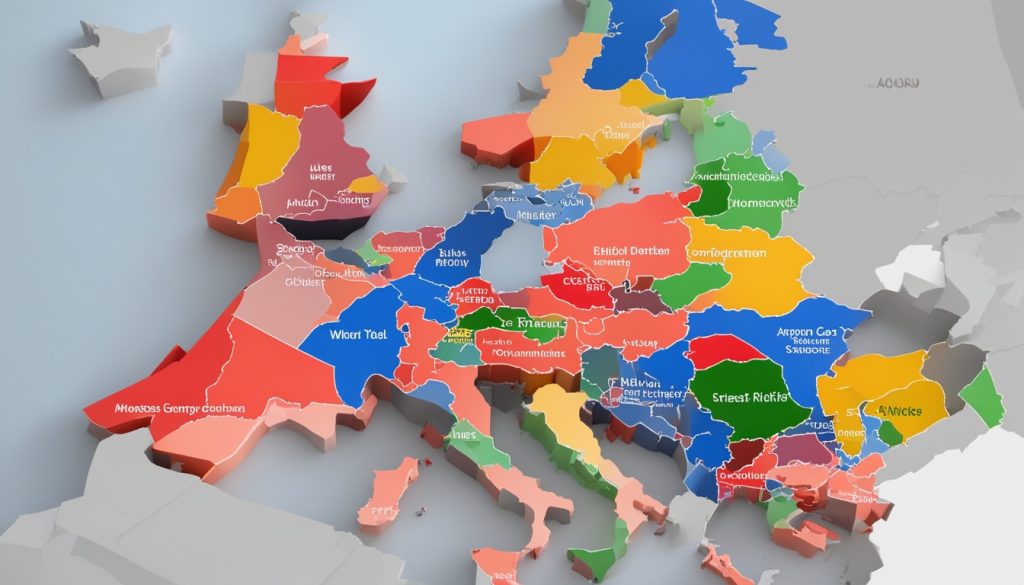
Exploring the real estate market in Belgium, Spain, and the Netherlands shows interesting differences. These differences attract people either to the sunny south or the practical north. The key factors are the housing prices and rental costs.
-
Marbella is known for its luxury. The high property prices show this. Yet, people still want to buy there, due to its attractiveness.
-
Brussels, with its charm, offers lower housing prices. This makes it popular among a varied group of people and investors.
-
Amsterdam combines beautiful canals with a lively culture. While it’s not as expensive as Marbella, it still has high demand. This affects housing prices and rental costs.
The sunny Costa del Sol has won over many from Belgium and the Netherlands. They are drawn by the sun and more affordable rental costs, even in pricey areas.
The real estate market is a story of contrasts. It’s about choosing between local charm or global appeal, North’s convenience or South’s relaxation. It’s also about deciding between making a smart investment or buying your dream home.
Comparing Educational Systems and Opportunities
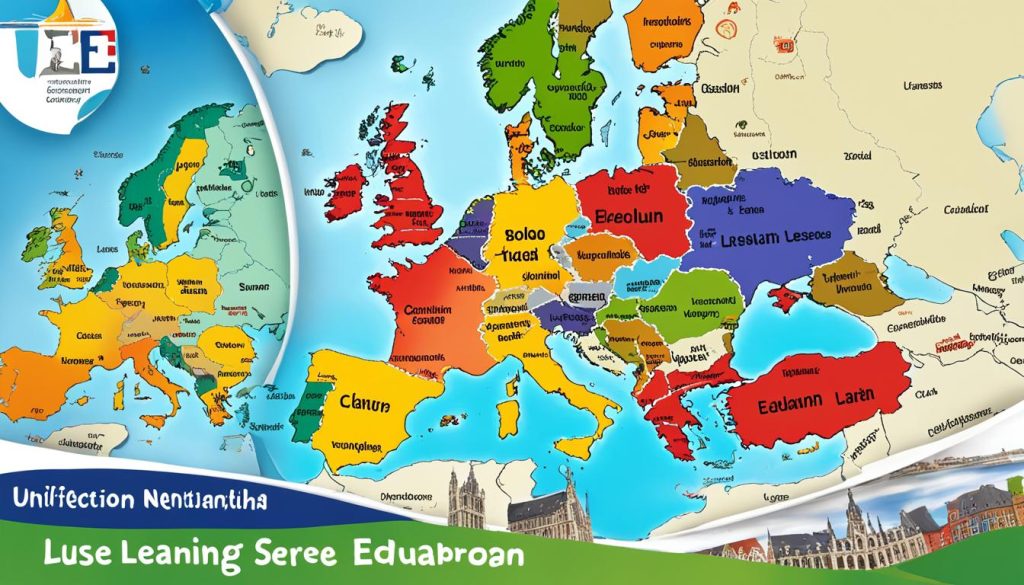
When we think about what shapes a country’s future, education is key. Belgium, Spain, and the Netherlands all have their unique ways of teaching in their academic institutions. They offer everything from top universities to specialized career schools, making education quality vital for growing their societies.
In Belgium, teaching in several languages is common, preparing students for a world that’s more connected. Spain combines old-school teaching with new ways of learning, giving students lots of different study programs to pick from. This helps everyone find something they’re interested in.
The Dutch focus on international awareness and practical learning. This approach is great for research and coming up with new ideas. They are also good at including technology and real-world experience in their lessons.
- Educational systems in Belgium, especially for secondary and higher learning environments.
- An insight into Spanish academic institutions and how they differ around the country.
- The Dutch study programs are geared towards the global job market and its needs.
Belgium, Spain, and the Netherlands all work hard to keep making their education better. They aim to give exciting, inclusive lessons that help students succeed in what they want to do. By doing this, they contribute to the world of knowledge and move us all forward.
Public Infrastructure and Transport Facilities
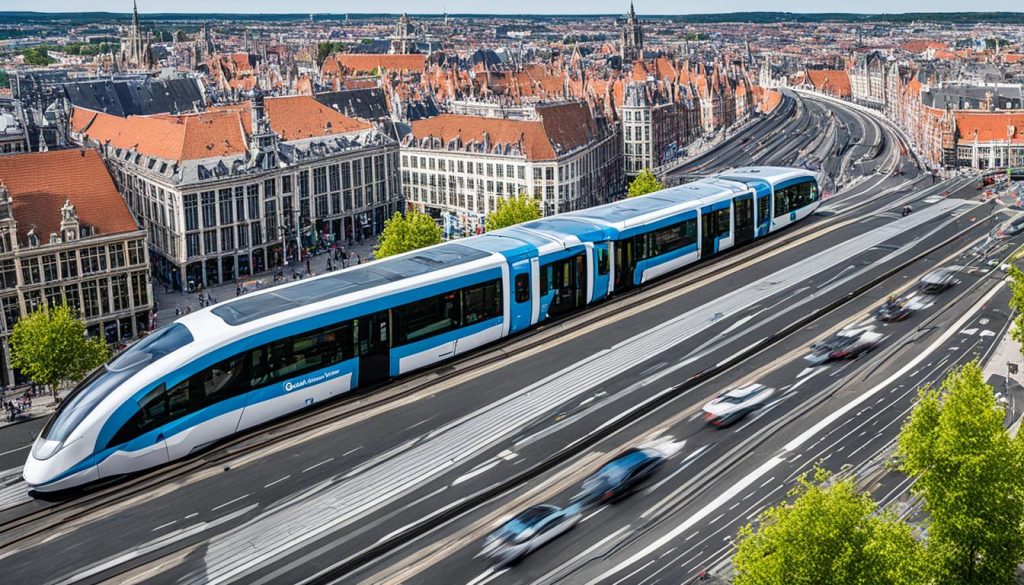
Belgium, Spain, and the Netherlands show us that good transport systems are key. Belgium has over 118,000 km of roads, and Spain stretches over 150,000 km. These roads are essential for the country’s operations.
The Netherlands uses its transport system to boost its economy and help people move easily. This system also makes it a key logistics centre in Europe.
- Expansive railway systems facilitating swift and reliable movement of goods and people across cities
- Innovations in cycling infrastructures, particularly in the Netherlands, promoting environmentally friendly commuting alternatives
- Ongoing investment in airport modernization and expansion to accommodate ever-increasing air travel demands
These countries invest in their infrastructure to improve public services and economic activities. Their efforts lead to better lives for their people.
Trams, buses, and metros link cities, making travel easier. International trains help merge different lands. These efforts aim for a future where everything is connected.
Climate and Environmental Quality
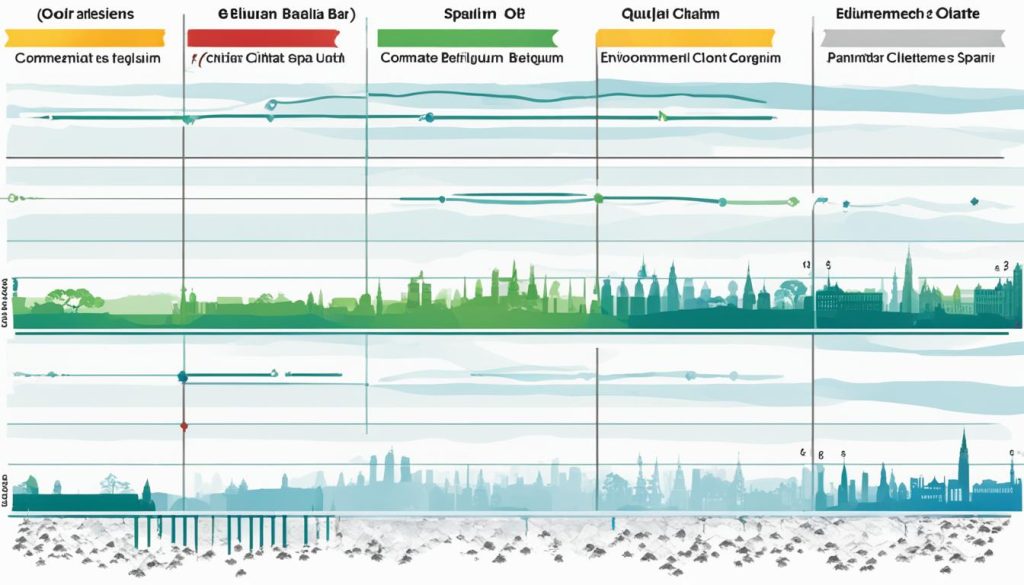
The climate comparison between Belgium and Spain shows how weather affects living. Belgium has cooler weather patterns and moderate seasonal temperatures. This is quite different from Spain’s warmer and sunnier weather. People think about the environmental quality based on what weather they like and can handle. This is key for anyone thinking of moving.
- Belgium’s summers are milder, and winters are cold, averaging 14.8 °C in the day. This climate is often called maritime and mild.
- Spain has warmer weather, with an average daytime temperature of 21.4 °C. This reflects its Mediterranean and continental climate.
The weather patterns affect more than just comfort. They also influence things like how plants grow, outdoor fun, and how much energy we use.
Knowing about these climates helps people make smart choices about where they live and their way of life. It sparks talks on how to keep and make the environment better. This considers the different places and weather that make each country unique. Thus, the contrasting climate comparison between Belgium and Spain shows us the environmental quality of each place.
Ease of Doing Business
Assessing a nation’s business environment reveals much about its economic health. The unique entrepreneurial climate of each country affects how investors and business owners make decisions. We explore how Belgium, Spain, and the Netherlands offer different opportunities through their market strategies and rules.
When it comes to market openness, Belgium, Spain, and the Netherlands have varied approaches. Their level of openness influences both foreign investment and local businesses’ ability to reach global markets. Let’s look at what sets these countries apart:
- Belgium’s prime location in Europe’s heart makes it ideal for logistics and global business activities.
- Spain focuses on innovation and tech start-ups, providing fresh opportunities for business minds.
- The Netherlands is celebrated for its open economy, innovative solutions, and strong trading networks.
The rules each country has play a big role in how easy it is to do business there. A helpful and quick-to-respond set of rules can cut through the red tape that slows businesses down:
- In Belgium, a detailed government structure means businesses face complex regulatory challenges.
- Spain, however, is trying to cut down on bureaucracy to make starting and running businesses easier.
- The Netherlands promotes entrepreneurship with policies that support business growth.
Exploring the business environments, it’s clear these nations are dedicated to creating favorable conditions for business. They each bring their own benefits and hurdles to the table.
Social Welfare and Governmental Support Systems
A nation’s social security net greatly affects its citizens’ quality of life. In Western Europe, each country has its own welfare programs. These programs show us how governments help their people and what they value in caring for society.
When we look at social security in Belgium, Spain, and the Netherlands, we see a wide range of benefits. These include unemployment aid and health care supplements. Welfare programs are key in maintaining living standards and ensuring everyone gets help when needed.
- Belgium is known for its generous public assistance, encompassing healthcare, family benefits, and pensions. The social security programs are comprehensive, offering support from cradle to retirement.
- Spain, while confronted with economic challenges, extends a range of welfare programs with a focus on employment-related benefits and public healthcare, aiming to provide a safety net amidst fluctuating employment rates.
- The Netherlands features a well-structured system of government benefits that underscores its commitment to social welfare. It includes highly regarded disability insurance and elder care — programs reflecting an advanced approach to public assistance.
The success of welfare programs is judged by how well they cover needs, how easy they are to access, and if they provide enough support. It’s essential to keep evaluating these programs. This helps them adapt to new economic situations and changing needs.
Looking at these welfare systems shows a common European value: solidarity. Though the benefits vary, the goal is the same across the board. They aim to offer fair and significant support to everyone. This effort shows a commitment to improving welfare, highlighting progress in Western Europe.
Cultural and Recreational Quality of Life
The cultural heritage of Belgium, Spain, and the Netherlands boosts their citizens’ quality of life. It plays a key role in art and entertainment. These nations are rich in history and blend tradition with modern leisure.
In Belgium, you’ll find medieval castles and Renaissance festivals. There are many museums and art galleries too. Artists like Rubens and van Eyck still influence Belgian culture.
Spaniards enjoy vibrant cultural traditions. They are famous for lively fiestas, flamenco, and the art of Dalí and Picasso.
The Netherlands is known for its golden age painters, like Rembrandt and Vermeer. Amsterdam’s canals, a UNESCO site, show how culture and leisure mix.
- Belgium’s jazz festivals show its love for music and entertainment.
- Spain’s food, from tapas to modern dining, brings joy to food lovers.
- In the Netherlands, cycling makes commuting fun and keeps people healthy.
These cultural activities boost local traditions and draw visitors worldwide. This creates a vibrant atmosphere that encourages art, history, and innovation. The rich cultural and leisure opportunities in these European countries make life more enjoyable. They support a lifestyle filled with creativity, fun, and wellness.
Expatriate Communities and Integration
The expatriate life in countries like Belgium, Spain, and the Netherlands offers a rich tapestry. These nations have vibrant expatriate communities that welcome new people. Community engagement is key to helping expats settle into their new homes. It makes the complex process easier.
Cultural integration comes through many activities, like language classes and social events. These help expatriates feel more connected to their new home. There are also expat support services available. They provide help with legal documents and understanding local traditions, making settling in smoother.
-
Language and Culture Workshops: Language classes teach expats to communicate and understand local customs. This helps in daily life and cultural integration.
-
Social Networking Groups: Joining clubs and online groups helps expats meet others. These platforms support community engagement and cultural exchange.
-
Local Community Events: Being part of local events helps expats learn about their new culture. This deepens their understanding and appreciation.
-
Expat Support Services: There are organisations that offer vital help to expats. They assist with legal matters, healthcare, and finding jobs.
Expatriates smoothly blend their own culture with their new country’s traditions through these experiences. Success depends on helpful resources and a welcoming community. This benefits both the individuals and the diverse culture of their new country.
Conclusion
Our detailed comparison looks at life in Belgium, Spain, and the Netherlands. Each country stands out for different reasons. Belgium offers high incomes and top healthcare. Spain is great for its affordable living and warm climate, perfect for relaxing and enjoying the culture.
The Netherlands is known for its efficient and innovative approach, especially in transport. When thinking about moving, consider housing, jobs, and social benefits each place offers. These countries show Europe’s commitment to strong social support.
Exploring these countries’ economic, healthcare, and cultural aspects gives great insight. Choosing between them depends on what you value most in life and work. This comparison helps those looking to start anew in Western or Southern Europe.

